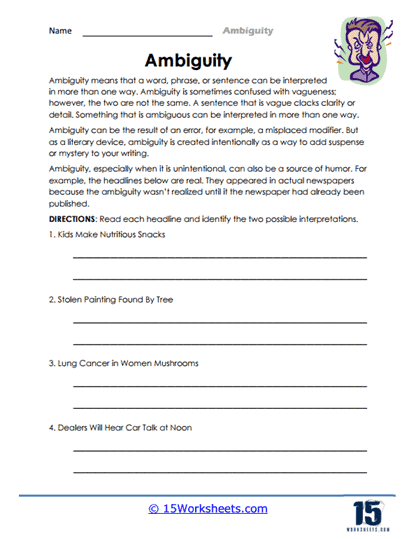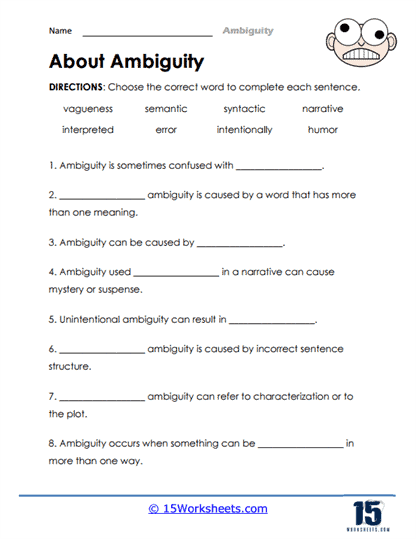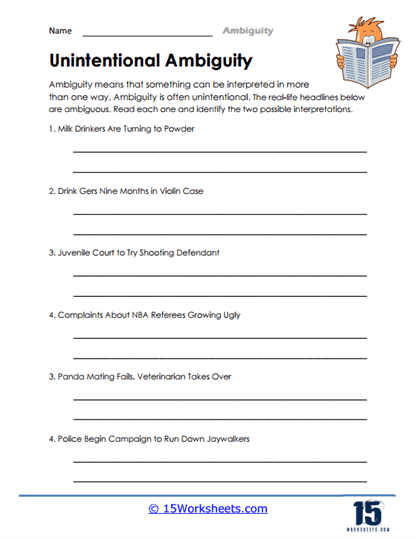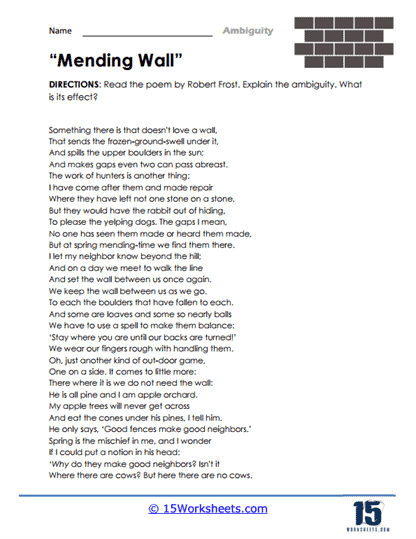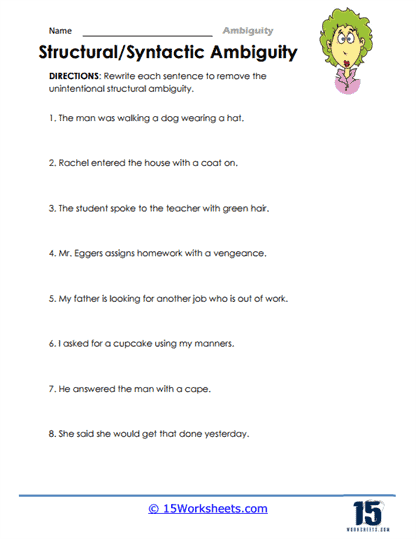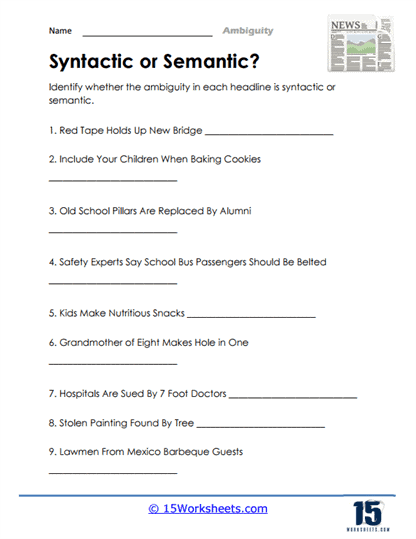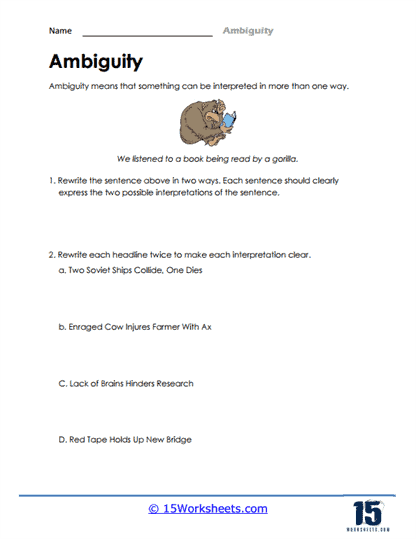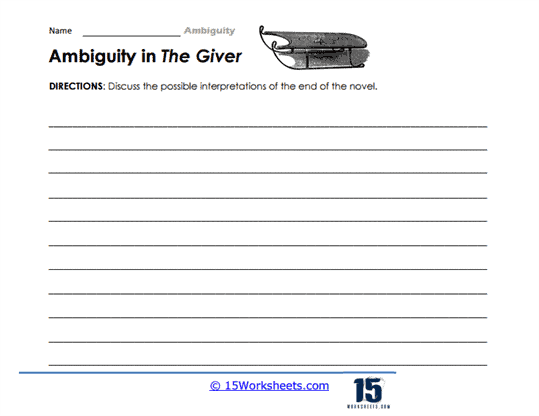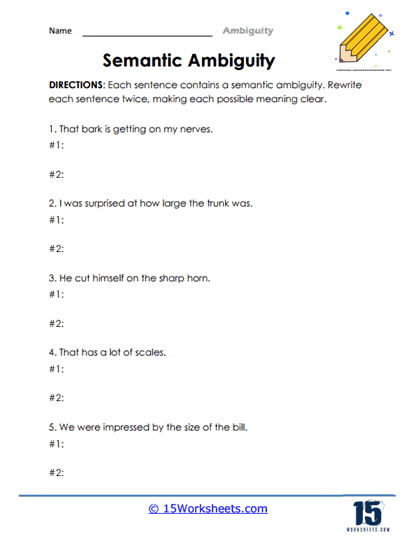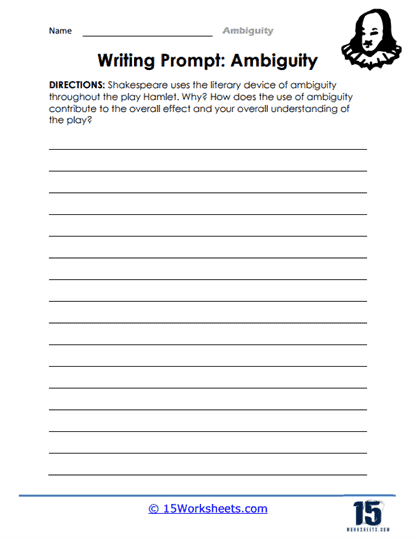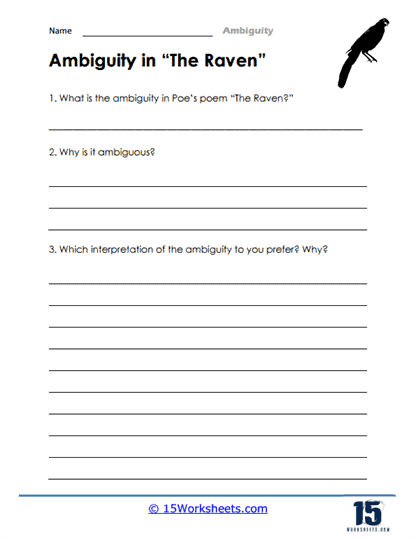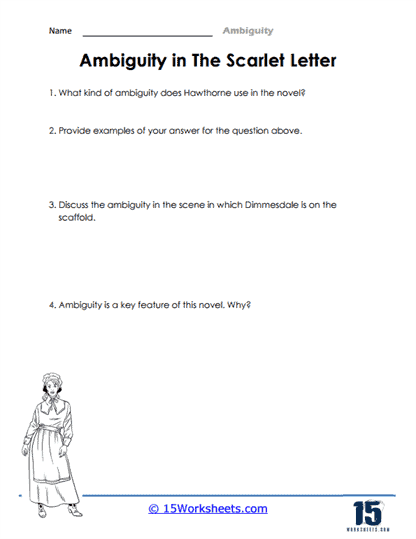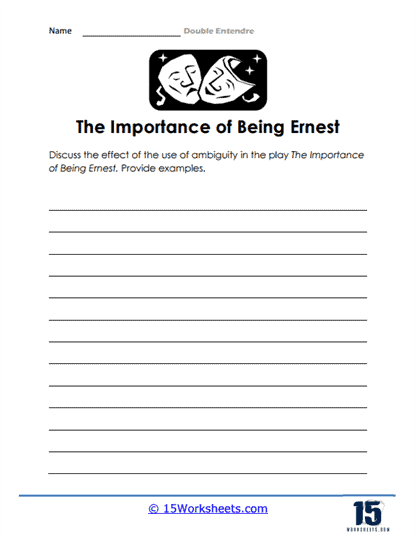Ambiguity Worksheets
All About These 15 Worksheets
Ambiguity, the presence of multiple interpretations or meanings in a single statement, is a fascinating linguistic phenomenon that pervades our daily communication. While it can add depth and complexity to literature and art, ambiguity can also lead to confusion and misunderstandings in everyday conversation. Teaching students to recognize and navigate ambiguity is essential for their language and critical thinking skills.
To empower students with the ability to decode complex language structures and engage in clear communication, we proudly present a collection of 15 worksheets on Ambiguity. These worksheets are thoughtfully designed to provide students with structured and engaging opportunities to explore and understand the concept of ambiguity and its implications.
In these worksheets, you’ll see sentences or phrases that can be understood in different ways. Sometimes, a word can have different meanings, or a sentence can be structured in a way that makes it unclear. The worksheets will ask you questions to help you find the different possible meanings and think about how to make things clearer.
The goal of these worksheets is to make you better at understanding and using this type of language. They help you think carefully about what people say or write, so you can communicate more clearly and avoid confusion. Teachers use these worksheets in language classes to help students become better at understanding and expressing themselves.
Why Do Authors Use Ambiguity as a Literary Device?
Ambiguity, as a literary technique, refers to the intentional use of words, phrases, or situations that have multiple interpretations or meanings. It creates a sense of uncertainty or openness in the text, allowing readers to engage actively with the work and draw their own conclusions. Ambiguity can add depth, complexity, and nuance to a literary piece. Here are three examples of ambiguity as a literary technique:
Hamlet – In William Shakespeare’s play “Hamlet,” the character Hamlet utters the famous line, “To be, or not to be, that is the question.” This line contains ambiguity as it raises questions about the meaning of existence and the choices one faces in life. The phrase “to be” can be interpreted in multiple ways, inviting readers to contemplate different philosophical perspectives.
The Great Gatsby – In F. Scott Fitzgerald’s novel “The Great Gatsby,” the character Jay Gatsby is described as having “an extraordinary gift for hope.” This description carries ambiguity as it leaves room for interpretation. Is Gatsby’s hope admirable and inspiring, or is it a form of naive idealism and self-delusion? The ambiguity surrounding Gatsby’s hope contributes to the novel’s exploration of the American Dream and the complexities of human aspirations.
The Raven – In Edgar Allan Poe’s poem “The Raven,” the repeated phrase “nevermore” is deliberately ambiguous. While the word appears to be a response from the titular bird to the narrator’s questions, it takes on additional layers of meaning. “Nevermore” can be understood as a symbol of loss, grief, and the relentless passage of time, leaving readers to interpret its significance within the poem’s larger themes of despair and mortality.
The Importance of Understanding Ambiguity For Students
Understanding ambiguity is of great importance for several reasons:
- Critical Thinking: Recognizing and deciphering ambiguous statements sharpens critical thinking skills. It encourages students to question and analyze language more deeply.
- Effective Communication: In an increasingly interconnected world, effective communication is paramount. Teaching students to disentangle ambiguity enhances their ability to express themselves clearly and interpret others’ messages accurately.
- Literary Analysis: Ambiguity is a key element in literature and art. Teaching students to appreciate and analyze ambiguity in literature broadens their understanding of complex texts and enhances their literary analysis skills.
- Problem Solving: In real-life scenarios, ambiguity often emerges in problem-solving contexts. Developing the ability to identify and address ambiguity is crucial for tackling complex challenges.
Benefits of These Ambiguity Worksheets
This worksheet collection offers numerous advantages for students:
- Structured Learning: The worksheets are thoughtfully organized to provide students with a structured learning experience. They progress from basic exercises to more complex tasks, ensuring students build a strong foundation in recognizing and deciphering ambiguity.
- Engaging Activities: Each worksheet incorporates fun and interactive activities, including analyzing real-world examples, rewriting ambiguous sentences, and engaging in discussions. These activities make learning about ambiguity enjoyable, keeping students motivated and interested.
- Versatility: These worksheets can be used in various educational settings, including classrooms, language arts workshops, and debate clubs. They are adaptable to students of different ages and proficiency levels.
- Enhanced Critical Thinking: Proficiency in identifying and addressing ambiguity cultivates sharper critical thinking skills, empowering students to navigate complex linguistic and cognitive challenges.
- Improved Communication Skills: Understanding ambiguity enables students to engage in more effective and clear communication, a valuable skill in both academic and real-world settings.
This collection of Ambiguity worksheets is a valuable resource for educators and parents committed to nurturing critical thinking, effective communication, and problem-solving skills in students. Proficiency in recognizing and addressing ambiguity equips individuals with the tools to navigate complex issues, make informed decisions, and engage in thoughtful discourse.
This collection is an investment in their future success, ensuring they have the skills to thrive in an increasingly interconnected and ambiguous world. Embrace these Ambiguity worksheets and watch your students excel in their journey toward becoming critical thinkers and adept communicators.

